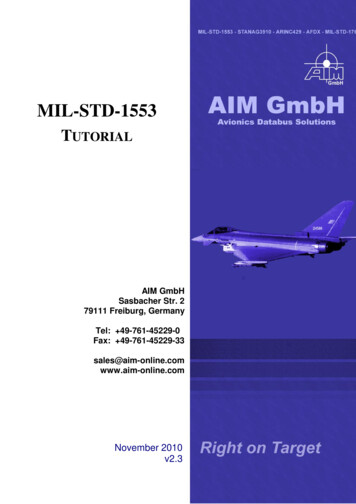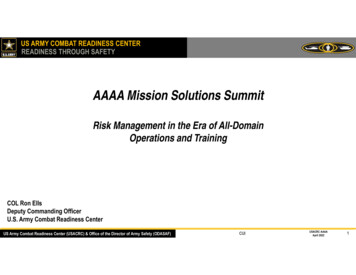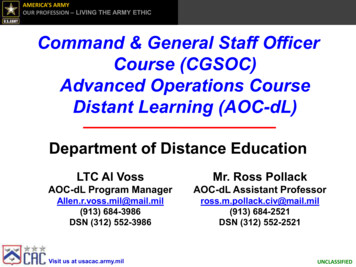
Transcription
BURKEWRIGHTENDURING SUCCESS: CONSOLIDATION OF GAINS IN LARGE-SCALE COMBAT OPERATIONSU.S. Army Combined Arms ion of Gainsin Large-Scale Combat OperationsEdited by Eric M. Burke and Donald P. WrightLARGE-SCALE COMBATOPERATIONS SERIESArmy University Press
Cover image: Photograph of the Mopping Up Cierges drawing by WallaceMorgan. Courtesy of the National Archives and Records Administration.Original tear graphic: Designed by Layerace/Freepik, freepik.comOriginal paper texture: Created by Freepik, freepik.comComposite cover design: Dale E. Cordes, Army University Press
This book is part of The US Army Large-ScaleCombat Operations Series, which includes:Weaving the Tangled Web: Military Deceptionin Large-Scale Combat OperationsBringing Order to Chaos: Historical Case Studies ofCombined Arms Maneuver in Large-Scale Combat OperationsLethal and Non-Lethal Fires: Historical Case Studiesof Converging Cross-Domain Firesin Large-Scale Combat OperationsThe Long Haul: Historical Case Studies of Sustainmentin Large-Scale Combat OperationsDeep Maneuver: Historical Case Studies ofManeuver in Large-Scale Combat OperationsInto the Breach: Historical Case Studies ofMobility Operations in Large-Scale Combat OperationsPerceptions Are Reality: Historical Case Studies ofInformation Operations in Large-Scale Combat OperationsThe Competitive Advantage: Historical Case Studies ofSpecial Operations Forces in Large-Scale Combat OperationsThe Last 100 Yards: the Crucible ofClose Combat in Large-Scale Combat OperationsMaintaining the High Ground: The Profession andEthic in Large-Scale Combat OperationsDeep Operations: Theoretical Approaches to Fighting DeepEnduring Success: Consolidation of Gainsin Large-Scale Combat Operations
Enduring SuccessConsolidation of Gains inLarge-Scale Combat OperationsEdited byEric M. Burke and Donald P. WrightArmy University PressFort Leavenworth, Kansas
Library of Congress Cataloging-in-Publication DataNames: Burke, Eric Michael, 1987- editor. Wright, Donald P., 1964editor. Army University Press (U.S.), issuing body.Title: Enduring Success: Consolidation of Gains in Large-Scale CombatOperations / edited by Eric M. Burke and Donald P. Wright.Other titles: Enduring Success (Army University Press (U.S.) Consolidation of Gains in Large-Scale Combat Operations US Armylarge-scale combat operations series.Description: Fort Leavenworth, Kansas : Army University Press,2022. Series: The US Army large-scale combat operations series Includes bibliographical references.Identifiers: LCCN 2021055085 (print) LCCN 2021055086 (ebook) ISBN 9781940804842 (paperback).Subjects: LCSH: United States. Army--Stability operations--Case studies. Consolidation of gains (Military science)--United States--Case studies. Operational art (Military science)--History--Case studies. United States-History, Military--Case studies.Classification: LCC U167.5.S68 E63 2022 (print) LCC U167.5.S68(ebook) DDC 355.0280973--dc23/eng/20211209 SUDOC D 110.20:C 76.LC record available at https://lccn.loc.gov/2021055085.LC ebook record available at https://lccn.loc.gov/2021055086.2022Army University Press publications cover a varietyof military history topics. The views expressed in thisArmy University Press publication are those of theauthor(s) and not necessarily those of the Departmentof the Army or the Department of Defense. A full list ofdigital Army University Press publications is availableat https://www.armyupress.army.mil/Books/.The seal of the Army University Press authenticates this document asan official publication of the Army University Press. It is prohibitedto use the Army University Press official seal on any republicationwithout the express written permission of the Director of the ArmyUniversity Press.ivDiane R. Walker, EditorRobin D. Kern, Graphics
ForewordSince the Soviet Union’s fall in 1989, the specter of large-scale groundcombat against a peer adversary was remote. During the years following,the US Army found itself increasingly called upon to lead multinationaloperations in the lower to middle tiers of the range of military operationsand conflict continuum. The events of 11 September 2001 led to morethan fifteen years of intense focus on counterterrorism, counterinsurgency,and stability operations in Iraq and Afghanistan. An entire generation ofArmy leaders and soldiers was culturally imprinted by this experience. Weemerged as an Army more capable in limited contingency operations thanat any time in our nation’s history, but the geopolitical landscape continuesto shift and the risk of great power conflict is no longer a remote possibility.While our Army focused on limited contingency operations in theMiddle East and Southwest Asia, other regional and peer adversaries scrutinized US military processes and methods and adapted their own accordingly. As technology has proliferated and become accessible in even themost remote corners of the world, the US military’s competitive advantageis being challenged across all of the warfighting domains. In the last decade, we have witnessed an emergent China, a revanchist and aggressiveRussia, a menacing North Korea, and a cavalier Iranian regime. Each ofthese adversaries seeks to change the world order in their favor and contestUS strategic interests abroad. The chance for war against a peer or regional near-peer adversary has increased exponentially, and we must rapidlyshift our focus to successfully compete in all domains and across the fullrange of military operations.Over the last two years, the US Army has rapidly shifted the focus ofits doctrine, training, education, and leader development to increase readiness and capabilities to prevail in large-scale ground combat operationsagainst peer and near-peer threats. Our new doctrine, Field Manual (FM)3-0, Operations, dictates that the Army provide the joint force four uniquestrategic roles: shaping the security environment, preventing conflict, prevailing in large-scale combat operations, and consolidating gains to maketemporary success permanent.To enable this shift of focus, the Army is now attempting to change itsculture shaped by more than fifteen years of persistent limited-contingency operations. Leaders must recognize that the hard-won wisdom of theIraq and Afghanistan wars is important to retain but does not fully squarev
with the exponential lethality, hyperactive chaos, and accelerated tempoof the multi-domain battlefield when facing a peer or near-peer adversary.To emphasize the importance of the Army’s continued preparation forlarge-scale combat operations, the US Army Combined Arms Center haspublished these volumes of The US Army Large-Scale Combat OperationsSeries book set. The intent is to expand the knowledge and understanding of the contemporary issues the US Army faces by tapping our organizational memory to illuminate the future. The reader should reflect onthese case studies to analyze each situation, identify the doctrines at play,evaluate leaders’ actions, and determine what differentiated success fromfailure. Use them as a mechanism for discussion, debate, and intellectualexamination of lessons of the past and their application to today’s doctrine,organization, and training to best prepare the Army for large-scale combat.Relevant answers and tangible reminders of what makes us the world’sgreatest land power await in the stories of these volumes.Prepared for War!Michael D. LundyLieutenant General, US ArmyCommanding GeneralUS Army Combined Arms CenterOctober 2018vi
ContentsForeword vIntroductionby Eric M. Burke and Donald P. Wright 1Chapter 1—Benevolently Consolidating Ill-Gotten Gains:The US Army in the Philippines, 1898–1902by Lt. Col. (Retired) Joseph G. D. Babb and Lt. Col. Nathaniel H. Babb 9Chapter 2—Securing the Aufmarsch: German Consolidation of Gainsduring the August 1914 Belgium Invasionby Lt. Col. William C. Baker 41Chapter 3—The AEF and Consolidation of Gains during theMeuse-Argonne Offensive, 1918by Christopher W. Davis 59Chapter 4—Losing the “Race for Tunisia” in 1942by Thomas E. Hanson 79Chapter 5—Consolidating Gains in Sicily, 1943by Gregory S. Hospodor 99Chapter 6—The Struggle against Chaos: Consolidating Gainsduring the Allied Invasion of Mainland Italyby Lt. Col. Steven T. Hampson 115Chapter 7—Consolidating Gains during Operation Market-Garden:The 101st Airborne Divisionby Matthew J. Margis 135Chapter 8—Connecting the Dots: US Efforts to Consolidate Gainsin the Central Pacific during World War IIby Gary W. Linhart 151Chapter 9—A Whirlwind of Violence: Soviet Consolidation of Gainsin Manchuria, 1945–46by Walker D. Mills and Timothy G. Heck 167Chapter 10—The Tentative Occupation of North Korea:October–December 1950by Eric B. Setzekorn 191Chapter 11—Mopping-up: Consolidating Gains in the EighthArmy Rear, 25th ID in South Korea, October 1950by Eric M. Burke 205vii
Chapter 12—An Incomplete Campaign: Consolidating Gainsduring the Invasion of Iraq, March–April 2003by Donald P. Wright 227Chapter 13—Conclusionby Col. (Retired) Richard D. Creed 251About the Authors 255viii
IllustrationsFigure 1.1. Map of the Philippines, 1899. 11Figure 1.2. Maj. Gen. Arthur MacArthur. 13Figure 1.3. Maj. Gen. Wesley Merritt. 16Figure 1.4. Map of the Capture of Manila, 1898. 22Figure 1.5. Maj. Gen. Ewell S. Otis. 24Figure 1.6. List of US Campaigns in the Philippines, 1899 and 1900. 28Figure 1.7. Brig. Gen. Adna Chaffee. 29Figure 1.8. Emilio Aguinaldo boarding the USS Vicksburg. 32Figure 1.9. Chronology of Major Events. 36Figure 2.1. Belgium Defenses Map, 4 August 1914. 45Figure 2.2. Consolidating Gains in Belgium, 20 August 1914. 51Figure 3.1. The Western Front-Meuse Argonne Offensive, Division andCorps Operations, 26 September‒11 November 1918 (all phases). 61Figure 3.2. Renault FT tanks and other military vehicles cross arepaired stone bridge near Beureuilles, Meuse, 28 September 1918. 66Figure 3.3. Crews from the 315th Engineers work on rock and mudroad reconstruction in France, September 1918. 73Figure 4.1. American soldiers pass the reviewing stand in the Alliedvictory parade along Avenue Gambetta, Tunis, 20 May 1943. 79Figure 4.2. Operation Torch Map, 8 November 1942. 84Figure 4.3. US President Franklin D. Roosevelt and French GeneralHenri Honoré Giraud at Casablanca, 19 January 1943. 85Figure 4.4. Captured colonial railway train, November 1942. 88Figure 4.5. Supplies unloaded at the docks in Algiers were storedoutdoors due to the lack of transportation to move them to units. 89Figure 4.6. US Army Air Force crewmen at breakfast in the NorthAfrican Desert, January 1943. 91Figure 5.1. Allied Military Government of Occupied Territories(AMGOT) Organizational Chart. 101Figure 5.2. Sicily Campaign Map. 105ix
Figure 5.3. The SS Robert Rowan explodes, 11 July 1943. 109Figure 6.1. Map showing return of territory to the Italian government 119Figure 6.2. Citizens of Salerno gather in front of “Proclamation No. 1,”posted by the Allied Military Government, 10 September 1943. 121Figure 6.3. Sign on Naples Road warns soldiers against lice, the vectorfor typhus. 130Figure 7.1. Invasion from the Sky Map. 137Figure 7.2. Map of Operation Market-Garden, 17–26 September 1944. 147Figure 8.1. The Dual Drive: US Division of Command and OffensivePlan for the Pacific Theater. 153Figure 8.2. Neutralizing the Threat: US forces protect their lines of communication from bypassed threats. 157Figure 8.3. Formosa or Luzon, the two options to cut the Japanese offfrom the southern portion of their empire. 160Figure 9.1. Soviet troops from the 39th Army entering Wangyemiaoon 15 August. 169Figure 9.2. Map of the Soviet advance into Manchuria, 9 to 20 August1945. 173Figure 9.3. Soviet Troops in Harbin. 174Figure 9.4. Soviet soldiers removing machinery from a factory. 181Figure 9.5. The Manchu Ironworks in Anshan, Manchuria, after Soviettroops removed all of the steel rolling equipment. 182Figure 10.1. United Nations Advance into North Korea, October andNovember 1950. 192Figure 10.2. Map of Chinese and North Korean forces poised to attackUnited Nations forces. 199Figure 11.1. The 25th Infantry Division area of responsibility, October1950. 207Figure 11.2. The 24th Regimental Combat Team zone of responsibility,16 October 1950. 213Figure 12.1. Phases of the Iraq Campaign. 229Figure 12.2. Map of Coalition Invasion of Iraq, March–May 2003. 231x
IntroductionEric M. Burke and Donald P. WrightThe publication of the US Army’s Field Manual (FM) 3-0, Operations, in 2017 generated a great deal of attention within the Army aswell as among outside observers. Most of that attention focused on themanual’s renewed emphasis on large-scale combat operations after theArmy’s prolonged involvement in the Global War on Terrorism (GWOT).Aggressive actions by emerging adversaries like Russia and China convinced senior leaders to reorient the Army from recent experiences characterized by counterinsurgency and small unit combat actions toward anew doctrine that emphasized large-scale combat. Soldiers and observerswho continue to debate the wisdom of this reorientation largely overlookFM 3-0’s attention to Consolidation of Gains. This concept incorporateshard-won lessons learned in the GWOT about the need to solidify strategic gains immediately after large-scale combat operations. While theArmy briefly introduced Consolidation of Gains in its 2016 Army Doctrine Reference Publication (ADRP) 3-0, the 2017 FM 3-0 includes anentire chapter on the concept, effectively elevating its importance in theArmy’s doctrinal framework. That chapter defines Consolidation of Gainsas actions that “make enduring any temporary operational success and setthe conditions for a stable environment.”1 Further, it states that Consolidation of Gains actions “are about exploiting tactical success by establishing security and stability in a manner decisive enough to achieve nationalstrategic aims.”2 Put differently, Consolidation of Gains represents anyand all actions necessary to ensure that military success at the tacticaland operational levels supports the durable attainment of overall politicalobjectives at the strategic level.3Sensitivity to the needs of Army forces to study, train, plan, and prepare for such broadly defined missions has a much deeper past. Since theadvent of the Kennedy “Flexible Response” era in 1962, the Army hasgrounded its doctrine on preparing troops for a spectrum of missions ranging from peacetime support of both domestic and foreign governmentsto major theater wars. While the Army’s doctrinal emphasis on responsibilities other than large-scale combat operations against Soviet forcesin Europe waned during the latter decades of the Cold War, the 1993 FM100-5, Operations, renewed the requirement to prepare for the full rangeof military operations. Additionally, whereas previous doctrine suggestedthe Army would operate in conflicts involving a single threat ranging from1
guerrilla insurgency to nuclear war, the 1993 manual warned that soldierswould often confront simultaneous threats from across the conflict spectrum. In 2001, this concept was embodied within the Army’s full spectrumoperations doctrine, which it used during the early years of the GWOT.The 2017 FM 3-0 retained this full spectrum foundation, which the Armycalled Unified Land Operations.Much in the spirit of predecessor full spectrum operations doctrine,the most recent FM 3-0 generally characterizes Consolidation of Gains as“a broad array of tasks combined in variable ways over time in a specificoperational context” and makes it clear that the term is “not a synonym forstability, counterinsurgency, or nation-building.”4 Due to the diverse rangeof strategic and political objectives it may be directed to achieve, the Armycannot establish a finite list of tasks for Consolidation of Gains actions.Instead, they are defined spatially as those operations taking place wherelarge-scale combat operations are not underway, though they may be ongoing within immediately adjacent areas. The manual includes examplessuch as neutralizing bypassed enemy units, handling enemy prisoners ofwar and displaced persons, seizing weapons storage sites, securing lines ofcommunication, establishing public order, and conducting humanitarianassistance—as well as more complex activities such as restoring key infrastructure and services and establishing governance. Such missions andtasks must be calibrated to the larger political context of a particular military campaign in order to ensure that battlefield successes are durable andstrategically relevant. Importantly, FM 3-0 mandates that commandersplan for Consolidation of Gains and instructs them to establish a consolidation area where these activities will take place, assigning responsibilityfor operations in that area to a subordinate commander. While civil affairs, engineers, military police, and other special units are often required,maneuver forces remain critical to Consolidation of Gains, especially forestablishing security within the consolidation area.This volume in the US Army Large-Scale Combat Operations Serieslooks to the past to sharpen current understanding of this concept. The volume’s contributors faced significant challenges in researching relevant historical cases to illustrate Consolidation of Gains. First, primary documentation of Consolidation of Gains actions is rare in comparison to first-handaccounts of combat operations. Our authors used innovative means to recover accounts of what were often considered minor operations conductedin rear areas. Second, there is no established body of scholarly works onConsolidation of Gains; most published operational military history tendsto focus on combat operations at the tip of the spear, paying little attention2
to what occurred behind the front lines. Moreover, a very limited numberof published works substantively address the concept of Consolidation ofGains as a doctrinal concept. A significant number of those works conflate the concept of Consolidation of Gains with the more narrowly definedlong-term effort called “nation-building” and are usually holistic examinations of the reconstruction of economic, social, and political institutions incountries where established governments were removed by military force,leaving a vacuum of political authority. As Nadia Schadlow and other security studies scholars have observed, the US military has historically avoided planning for sustained nation-building operations, even though they arethe only US government organizations with the resources and self-defensecapabilities to take on this monumental task in highly destabilized environments.5 This pattern of avoiding preliminary planning for nation-buildinghas proven all the more damaging when nation-building itself was a primary political objective of a campaign, as in Operation Iraqi Freedom.Rather than address the broad subject of nation-building, this volumefocuses on a wide range of military actions that take place in the spatial—and often temporal—wake of large-scale combat operations. Each of thechapters recount how commanders leading forces approached (or attempted to avoid) the problem of securing tactical and operational successes behind the front lines and link those successes to higher-level political objectives of a campaign as established by civilian leadership. In some of thesecases, military staffs planned for specific Consolidation of Gains actionsonly to find that they often overlooked tasks that ultimately proved criticalto achieving strategic and political goals. In others, lack of strategic guidance at the outset of conflicts and shifting strategic goals during campaignsundermined the commander’s ability to plan for and conduct Consolidationof Gains. Many of the chapters reveal how important a military institution’sculture and norms are to the successful conduct of Consolidation of Gains.For many armies, victory in battle was considered the sole measure of success. What occurred in the wake of combat was either not the concern ofthe commander or actions relegated to Civil Affairs or other noncombatspecialty units. These assumptions often led to hurried improvisations, including the unplanned commitment of maneuver forces to tasks far fromthe front lines. In some cases, poor assumptions and improvisations led toConsolidation of Gains actions that succeeded at the tactical level but ultimately undermined the attainment of overall political goals.The chapter that opens the volume examines the American experience with Consolidating Gains in the Philippines between 1898 and 1902.Geoff Babb traces the conflict’s evolution from large-scale combat opera3
tions against Spanish military forces to the eventual emergence of a Filipino insurgency. Throughout this period, US military commanders in thePhilippines were hamstrung by reticent and ambiguous political guidancefrom Washington, DC. This ambiguity contributed to an environment inwhich tactical-level commanders felt compelled to use coercive and abusive means to achieve a benevolent outcome at the strategic level. Thatcontradiction has stained the conflict’s legacy through the present day.The next two chapters address Consolidation of Gains in the FirstWorld War. Lt. Col. Casey Baker recounts how the Imperial German Armyplanned to secure and stabilize Belgian territory in the war’s opening western offensive in 1914. Due to faulty assumptions about how the Belgianswould defend their territory and the types of forces required to consolidategains, the Germans faced a complex campaign behind the front lines. Christopher Davis’s chapter on the Meuse-Argonne Offensive looks closely atthe American Expeditionary Forces (AEF) tactical-level actions to protectlines of communication, eliminate bypassed enemy forces, and completeother Consolidation of Gains actions. These operations were critical to theAEF maintaining the decisive tempo of the offensive, especially as a pandemic began to erode the combat power available to Allied commanders.The next three chapters on the Mediterranean Theater in the SecondWorld War address how the US Army’s understanding and conduct ofConsolidation of Gains improved between 1942 and 1945. Tom Hanson’schapter on Allied operations in North Africa describes how faulty assumptions about French governing capacity and political will created an unstable environment behind the front lines. Greg Hospodor follows withan account of the Allied campaign in Sicily, describing how senior UScommanders who learned from failures in North Africa first deployed civilaffairs teams and other units to quickly secure and stabilize areas seizedfrom Axis forces. Lt. Col. Steven Hampson’s chapter shifts the focus toConsolidation of Gains actions on the Italian peninsula, examining themature and sophisticated effort to address complex political, social, andeconomic challenges that threatened to destabilize Italian communitiesliberated by Allied combat operations.Three chapters on the Second World War in other theaters providedifferent perspectives on Consolidation of Gains. Matthew Margis’s discussion of the 82nd Airborne Division in Operation Market-Garden addresses forcible entry operations that often require a unit to conduct closecombat and Consolidation of Gains actions simultaneously. Gary Linhart’sanalysis of the Central Pacific campaign between 1942 and 1945 illus4
trates how a joint headquarters planned to secure lines of communicationas its forces moved toward the Japanese Home Islands. Timothy Heck andWalker Mills examine the Soviet Offensive in Manchuria at the very endof the war. Consolidation of Gains in that operation consisted of actionsthat exploited the local economy and population to achieve strategic goalsthat were quite different from those set by the Allies in Asia and elsewhere.The next two chapters on the Korean War reveal the breadth of Consolidation of Gains activities conducted during that conflict. Eric Burkefocuses on the August 1950 United Nations (UN) counteroffensive. In thatoffensive, the US Army’s 25th Infantry Division suddenly transitionedfrom large-scale combat operations to Consolidation of Gains actionssuch as eliminating bypassed enemy forces and reestablishing South Korean political authority in areas reclaimed from North Korean forces. EricSetzekorn’s chapter then follows the offensive as it swept north all the wayto the Chinese border, forcing the UN to plan for the occupation of NorthKorea. The December 1950 Chinese intervention ended the UN occupation, but prior to that, the US Army and its allies conducted Consolidationof Gains activities to establish stability and new governance in North Korea, albeit in a vacuum of political guidance.In the final chapter, Don Wright examines Consolidation of Gains inOperation Iraqi Freedom. Between November 2001 and February 2003.Coalition forces enjoyed ample time to prepare for the invasion of Iraqand planned for Consolidation of Gains actions that secured lines of communication and key infrastructure. Senior commanders failed to preparetheir forces to conduct broad-based security and stability operations oncelarge-scale combat had ceased, however. This lack of preparedness for themost basic Consolidation of Gains actions led to civil disorder, politicalconfusion, and ultimately the Coalition’s loss of legitimacy.The historical cases in this collection offer examples of how operations that US Army doctrine now calls Consolidation of Gains actionshave shaped past conflicts. These cases can serve as points of departurefor further discussion on how the US Army can integrate the concept ofconsolidating gains into its training and education so that future operationsconsistently support joint strategic objectives and national political goalsand ultimately achieve enduring success. Although history cannot predictthe future, carefully reconstructing and analyzing the past can illuminatewhat the future might hold. Providing historical insight is especially important when a new concept enters US Army doctrine.5
In creating this volume, we had ample assistance from numerous organizations and people. First and foremost, we would like to thank ourcontributors, who volunteered their time and expertise. They not only tookon a complex and overlooked historical subject but also patiently workedwith us through chapter reviews and correspondence to address the smallyet important details that make a project like this possible. Special thanksto Col. Rich Creed, who authored the conclusion and—as director of theCombined Arms Doctrine Directorate (CADD)—helped us frame the volume and choose historical cases that might prove most relevant and useful.Finally, thank you to the Army University Press Research and BooksTeam. Kate Dahlstrand and her editors took this project and did the hardwork of reviewing, editing, and designing. This book greatly benefittedfrom their expertise.6
Notes1. Department of the Army, Field Manual (FM) 3-0, Operations (Washington, DC: 2017), 8-1.2. FM 3-0, 8-2.3. “Consolidati
v Foreword Since the Soviet Union’s fall in 1989, the specter of large-scale ground combat against










